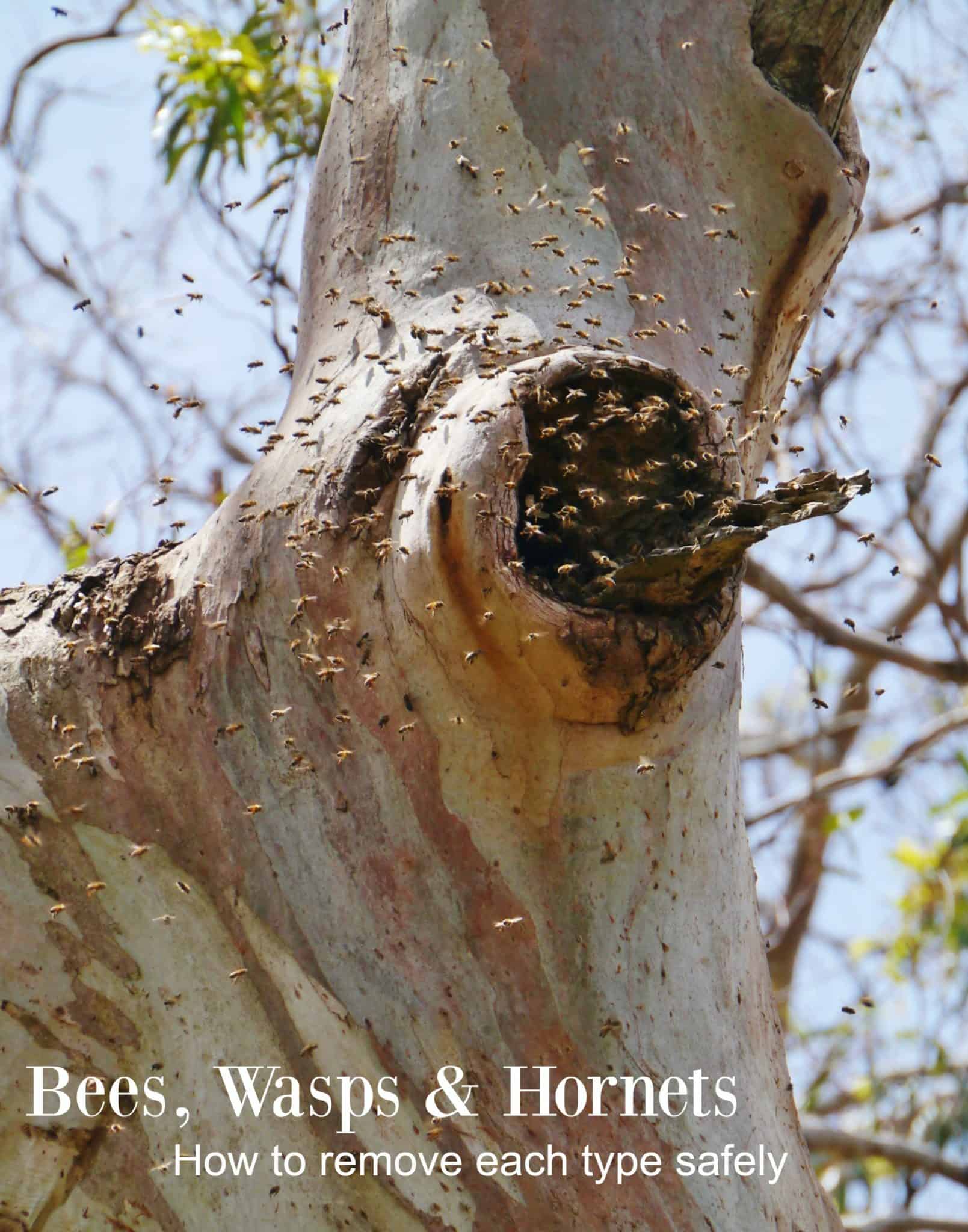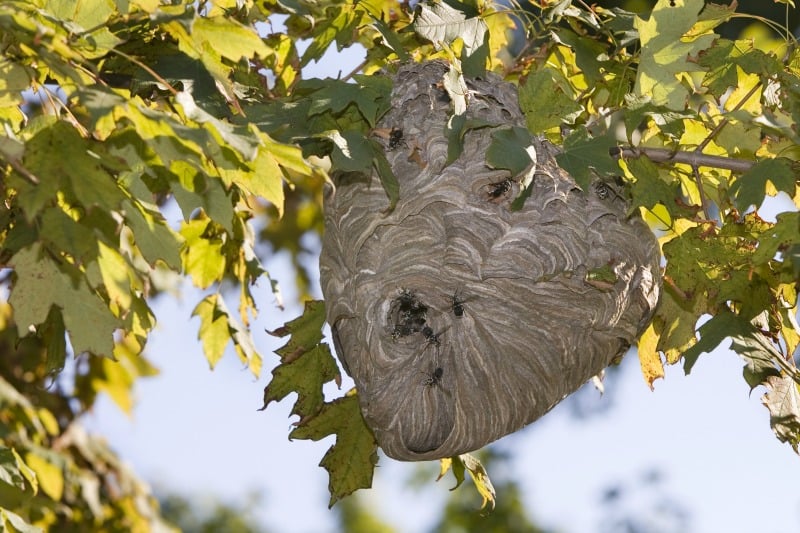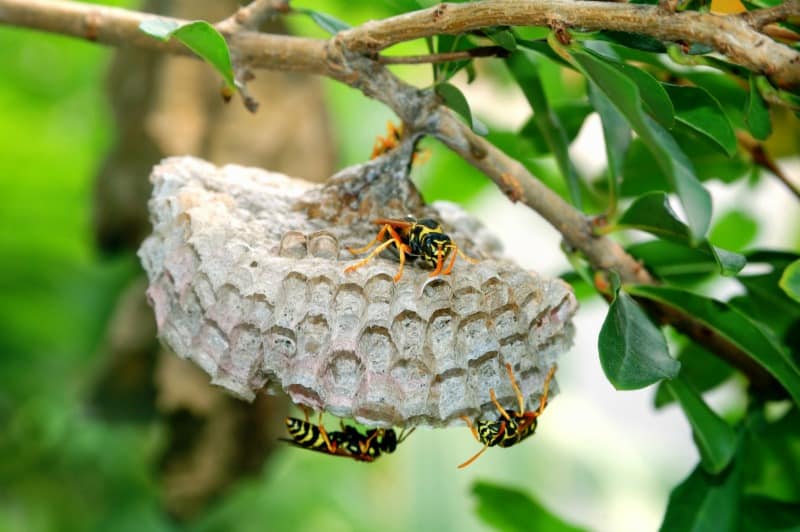Last Updated on June 16, 2016 by Ellen Christian
It’s important to deal with bee removal safely. Now that the warm weather has returned, you may have noticed more wasps and bees in your yard. We need beneficial insects including bees in our yards. They help keep some pests away and are responsible for a lot of the pollination that happens in your garden. As much as I love the good things that insects do, I don’t want stinging insects too close to my home or my family. Here are a few tips to handle bee removal safely.
Posts may be sponsored. This post contains affiliate links, which means I will make a commission at no extra cost to you should you click through and make a purchase. As an Amazon Associate I earn from qualifying purchases.
How to Approach Bee Removal Safely
There are two basic types of stinging pests you may want to have removed: bees and wasps. Each has slightly different nesting habits and will be approached in a different way. Honey bees tend to nest in cavities like an old tree stump, a crevice between your chimney and home, or inside the wall of your house. Wasps can include yellow jackets, hornets and paper wasps. Yellow jackets tend to nest in the ground, and you may disturb the nest while you’re mowing the grass which can cause a swarm. Hornets often nest in large grayish brown nests that can be found hanging in trees or bushes. A paper wasp will often build its nest under the eaves of your home or the deck. We find them in our chicken coop.
Honey bee removal
Removing a honey bee colony from your home can be very difficult, especially if it has been there for a few years. A colony that’s well established can have up to 100 pounds of honey stored in addition to many pounds of adults, larvae, and honeycomb. If you think there’s a honey bee colony in or near your home that should be removed, contact a professional. He can remove it safely and without killing the honey bees. Most of the time, honey bee colonies that are away from the home can be avoided until the colony swarms to a new location. If the colony is near your home or in an area you frequently go, it may need to be removed.
Yellowjacket removal
If you see yellowjackets coming up out of the ground on a warm morning, the chances are that you’ve found a yellow jacket nest. Yellowjackets are one of the most dangerous stinging insects because they can sting you repeatedly. On a cold or very cool morning, invert a glass bowl on top of the hole the yellowjackets are leaving. The queen finds an existing mouse or vole hole in the spring to begin the nest. Yellow jackets are not burrowing insects and don’t do the actual digging of the hole. They will die because they cannot dig another hole to leave the nest.
Hornet and paper wasp removal
You need to remove the hornet nest at night, once all the hornets have returned to the nest. Removing the nest during the day will not help. The existing hornets will simply rebuild a new nest in the same area. You should spray the pesticide directly into the hole of the nest. Always do this at night when it’s completely dark and never during the day. You should wear protective clothing when attempting hornet removal. For paper wasps, spray the pesticide directly onto the nest itself and cover as much of the exposed surface as possible. Avoid shining light directly onto the nest while working. This may wake up the paper wasps and hornets. Finish it during the day after you carefully watch the nest to be certain there is no movement. You can then remove the nests safely.
Bee Removal Safely and Naturally
If you’re looking for a non-toxic way to eliminate these stinging pests, some people have success using a mint oil spray and organic alternatives. Toxic pesticides should never be used near vegetation that will be eaten, livestock, poultry, pets or in play areas. Your local garden center or home improvement store should be able to direct you to a safe alternative and share resources to approach bee removal safely.
Resources for bee removal

Ellen is a busy mom of a 24-year-old son and 29-year-old daughter. She owns six blogs and is addicted to social media. She believes that it doesn’t have to be difficult to lead a healthy life. She shares simple healthy living tips to show busy women how to lead fulfilling lives. If you’d like to work together, email info@confessionsofanover-workedmom.com to chat.





Thanks for sharing the information about removing honey bees without having to kill them. They are so important for our environment and we need all the bees we can get! (Just not in our houses!)
I totally agree, Chrysa!
I had a nest of hornets in my old house and you gave some good advice up above. There are no joke that’s for sure. Great post and timely with the summer just around the corner
Glad to share, Kathleen. They certainly are no fun to deal with.
I haven’t been stung by a bee since I was a kid. I’ve certainly seen the wrong way to deal with these on social media so this is info much needed. Thankfully I live in the city for now but good to know and will tuck it away.
There definitely are some wrong ways to deal with them!
Thanks so much for sharing these tips. The hubs works outdoors and has come upon different nests and hives. He usually backs away and lets the homeowners deal with them by calling someone to take care of it. These tips can help him if need be.
Glad to help, Jess!
Sounds like something good to know! Luckily I live in a condo in a more urban environment. No bees 🙂
You’re lucky, but you may be surprised. They like to nest in gutters and under decks too!
This is good to know! Luckily I hadn’t had to deal with bee removal. Fingers cross I will never have to.
We generally do at least once a year. Comes with living in the country.